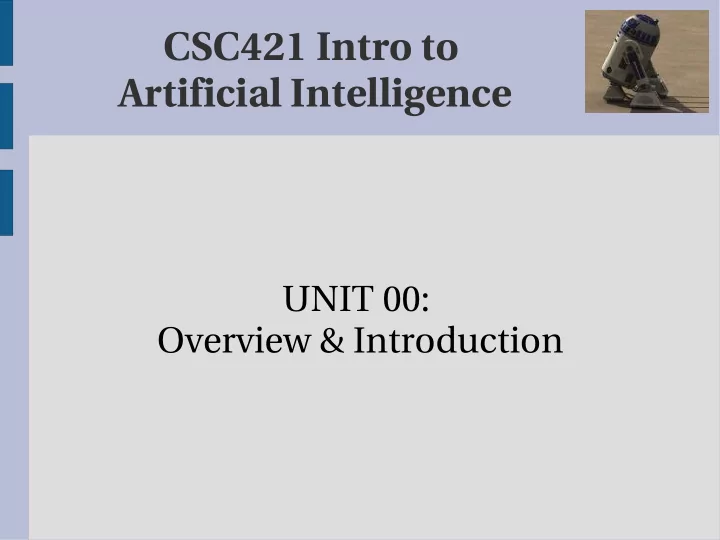

CSC421 Intro to Artificial Intelligence UNIT 00: Overview & Introduction
Overview ● Emphasis : – Agents as a way of thinking about AI and software in general ● Workload : – Balanced over the term – IMPORTANT: prepare for lectures – Suggested workplans ● Exams (midterm & final) – Open book ● Thoughts on cheating, copying, attendance
Extra interest group meeting ● Possibility of a 2-hour biweekly meeting to cover more history, advance topics, discussion, etc ● Student-driven ● NO EFFECT ON GRADE ● Only if enough interest ● Expression of interest by email: – gtzan@cs.uvic.ca
What is AI ? ● Do you know of any examples of applications of AI ? ● Major challenges ahead ? ● Why study AI ? ● What do you expect to learn in this course ? ● Along with molecular biology, AI is regularly cited at the “field I would most like to be in” by scientists in other disciplines. Do you agree ? Why ?
My favorite definition ● “Artificial Intelligence (AI) is the science of how to get machines to do the things they do in movies” - Dr. Astro Teller
4 approaches ● Systems that: – Think like humans Think rationally – Act like humans Act rationally
Acting Humanly: Turing Test ● Operational test for intelligent behavior: ● By 2000, a machine might have a 30% chance of fooling a human for 5 minutes ● Knowledge, reasoning, language understanding, learning ● Problems: Not reproducible, constructive, amendable to mathematical analysis
Thinking humanly: Cognitive modeling ● 1960s “cognitive revolution”: information processing psychology replaced prevailing orthodoxy of behaviorism ● Theories of how the brain works – Predicting and testing user subjects (top-down) – Direct analysis of neurological data (bottom-up) ● Cognitive science and cognitive neuroscience – today distinct from AI
Thinking rationally: Laws of thought ● Greek schools various forms of logic – Notation and rules of derivation for thoughts – Mechanization of computation/proof ● Direct line through mathematics and philosophy to AI ● Problems: – Not all intelligent behavior is mediated by logic deliberation – What is the purpose of thinking ? – What thoughts should I have ?
Acting rationally: The rational agent approach ● Rational behavior: doing the right thing ● That which is expected to maximize goal achievement given the available information ● Not necessarily just thinking: blinking reflex – but thinking should be in the service of rational action ● Advantages: – More general than laws of thought – More amendable to scientific development
Rational agents ● An agent is an entity that perceives and acts ● This course is about designing rational agents ● Abstractly, an agent is a function from precept histories to actions: f: P* -> A ● For any given class of environments, we seek the agent (or class of agents) with the best performance ● Caveat: computational resources
AI Prehistory Philosophy : logic, methods of reasoning mind as a physical system foundations of learning, language, rationality Mathematics: formal representation and proof algorithms, computation, (un)decidability, (in)tractability, probability Psychology : adaptation phenomena of perception and motor control experimental techniques (psychophysics etc) Economics : formal theory of rational decisions Linguistis : knowledge representation and grammar Neuroscience: Plastic physical substrate for mental activity Control theory: homeostatic systems, stability, simple optimal agent designs
Brief history of AI 1943: McCulloch & Pitts: Boolean circuit model of the brain 1950: Turing's “Computing Machinery and Intelligence” 1952-69: Look, Ma, no hands ! 1950s: Early AI programs, including Samuel's checkers program, Newell & Simon's Logic Theorist, Gelernter's Geometry Engine 1956 : Dartmouth meeting: “Artificial Intelligence” adopted 1965 : Robinson's complete algorithm for logical reasoning 1966-74: AI discovers computational complexity – Neural Network research almost disappears 1969-79: Early development of knowledge-based systems 1980-88: Expert systems industry booms 1988-93: Expert systems industry busts: “AI Winter”
Brief History of AI 1985-95: Neural networks return to popularity 1988- : Resurgance of probability; general increase in technical depth, “Nouvelle AI”: ALife, GAs, soft computing 1995- : Agents, agents, everywhere, ... 2003- : Human-level AI back on the agenda, games
Recommend
More recommend